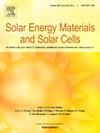Dynamic regulation of the photothermal conversion performances of nano-enhanced phase change material composited with ceramic foam subjected to external fields
IF 6.3
2区 材料科学
Q2 ENERGY & FUELS
引用次数: 0
Abstract
This study aims to comparatively analyze the melting characteristics of magnetic Fe3O4 nano-enhanced phase change materials (NEPCM) assisted by optimum filling strategies of Al2O3 foam ceramics, ultrasonic field and magnetic field under solar radiation. A visualization experimental platform consisting of an ultrasonic field, a magnetic field, and infrared thermography is constructed and used to evaluate in detail the evolution of the melting front, the temperature distribution, and the heat transfer mechanism under different experimental conditions in a square cavity. The results show that the 1 wt% NEPCM using an ultrasonic field has the highest solar energy conversion efficiency of 39.99 % among the 18 experimental groups. This suggests that the cavitation effect and acoustic flow effect induced by ultrasound with a power of 40 W periodic ultrasonic mechanical vibration improve the uniformity of the distribution of magnetic nanoparticles, resulting in improved heat transfer properties. In the experimental group where a magnetic field is applied, the downward movement of the melting interface is accelerated due to the force of the magnetic field on the Fe3O4 nanoparticle. Under the effect of localized porous filling, the solar conversion efficiency of 1 wt% NEPCM is 31.57 % and the total energy storage is as high as 14.39 kJ. With the increase of concentration, the solar conversion efficiency and total energy storage decrease gradually. However, under the simultaneous effect of magnetic field and localized porous filling, the solar conversion efficiency and energy storage show an opposite trend. From a comprehensive point of view, the application of periodic ultrasound with a power of 40 W can effectively improve the photothermal conversion capacity of the PCM.
纳米增强相变材料与陶瓷泡沫复合后在外力场作用下光热转换性能的动态调节
本研究旨在比较分析在太阳辐射下,磁性 Fe3O4 纳米增强相变材料(NEPCM)在 Al2O3 泡沫陶瓷、超声波场和磁场的最佳填充策略辅助下的熔化特性。构建了一个由超声场、磁场和红外热成像组成的可视化实验平台,用于详细评估方形空腔中不同实验条件下熔化前沿的演变、温度分布和传热机制。结果表明,在 18 组实验中,使用超声波场的 1 wt% NEPCM 的太阳能转换效率最高,达到 39.99%。这表明,功率为 40 W 的周期性超声波机械振动诱导的空化效应和声流效应改善了磁性纳米粒子的分布均匀性,从而提高了传热性能。在施加磁场的实验组中,由于磁场对 Fe3O4 纳米粒子的作用力,加速了熔化界面的向下运动。在局部多孔填充的作用下,1 wt% NEPCM 的太阳能转换效率为 31.57%,总储能高达 14.39 kJ。随着浓度的增加,太阳能转换效率和总储能逐渐降低。然而,在磁场和局部多孔填充的同时作用下,太阳能转换效率和能量储存呈现出相反的趋势。综合来看,应用功率为 40 W 的周期性超声波可有效提高 PCM 的光热转换能力。
本文章由计算机程序翻译,如有差异,请以英文原文为准。
求助全文
约1分钟内获得全文
求助全文
来源期刊

Solar Energy Materials and Solar Cells
工程技术-材料科学:综合
CiteScore
12.60
自引率
11.60%
发文量
513
审稿时长
47 days
期刊介绍:
Solar Energy Materials & Solar Cells is intended as a vehicle for the dissemination of research results on materials science and technology related to photovoltaic, photothermal and photoelectrochemical solar energy conversion. Materials science is taken in the broadest possible sense and encompasses physics, chemistry, optics, materials fabrication and analysis for all types of materials.
 求助内容:
求助内容: 应助结果提醒方式:
应助结果提醒方式:


